Electrodeposition of Calcium Carbonate and Magnesium Carbonate from Hard Water on Stainless-Steel Electrode to Prevent Natural Scaling Phenomenon
Abstract
:1. Introduction
2. Materials and Methods
3. Results and Discussion
3.1. Influence of Stirring Speed
3.2. Influence of the Cathode Area
3.3. Influence of the Current Intensity
3.4. Influence of the Anode Material
3.5. Influence of the Solid Deposit over the Cathode
3.6. Influence of Ca/Mg Ratio on the IC Removal
4. Conclusions
Supplementary Materials
Author Contributions
Funding
Institutional Review Board Statement
Informed Consent Statement
Data Availability Statement
Conflicts of Interest
References
- Lédion, J.; Leroy, P.; Labbé, J. Détermination du caractère incrustant d’une eau par un essai d’entartrage accéléré. TSM-L’eau 1985, 7, 323–328. [Google Scholar]
- Gabrielli, C.; Keddam, M.; Maurin, G.; Perrot, H.; Rosset, R.; Zidoune, M. Estimation of the deposition rate of thermal calcareous scaling by the electrochemical impedance technique. J. Electroanal. Chem. 1996, 412, 189–193. [Google Scholar] [CrossRef]
- Lin, W.; Colin, C.; Rosset, R. Caractérisation du pouvoir incrustant d’une eau par chronoampérométrie au potentiel optimal d’entartrage. TSM-L’eau 1990, 12, 613–620. [Google Scholar]
- Ketrane, R.; Leleyter, L.; Baraud, F.; Jeannin, M.; Gil, O.; Saidani, B. Characterization of natural scale deposits formed in southern Algeria groundwater. Effect of its major ions on calcium carbonate precipitation. Desalination 2010, 262, 21–30. [Google Scholar] [CrossRef]
- Ben-aazza, S.; Hadfi, A.; Mohareb, S.; Karmal, I.; Belattar, M.; Hafid, N.; Driouiche, A. Geochemical characterization and thermodynamic study of water scaling phenomenon at Tiznit region in Southern Morocco. Groundw. Sustain. Dev. 2020, 11, 100379. [Google Scholar] [CrossRef]
- Zhang, P.; Hu, J.; Li, W.; Qi, H. Research progress of brackish water desalination by reverse osmosis. J. Water Resour. Prot. 2013, 5, 304–309. [Google Scholar] [CrossRef] [Green Version]
- Badruzzaman, M.; Voutchkov, N.; Weinrich, L.; Jacangelo, J.G. Selection of pretreatment technologies for seawater reverse osmosis plants: A review. Desalination 2019, 449, 78–91. [Google Scholar] [CrossRef]
- Li, X.; Hasson, D.; Semiat, R.; Shemer, H. Intermediate concentrate demineralization techniques for enhanced brackish water reverse osmosis water recovery—A review. Desalination 2019, 466, 24–35. [Google Scholar] [CrossRef]
- Anis, S.F.; Hashaikeh, R.; Hilal, N. Reverse osmosis pretreatment technologies and future trends: A comprehensive review. Desalination 2019, 452, 159–195. [Google Scholar] [CrossRef] [Green Version]
- Matin, A.; Rahman, F.; Shaf, H.Z.; Zubair, S.M. Scaling of reverse osmosis membranes used in water desalination: Phenomena, impact, and control; future directions. Desalination 2019, 455, 135–157. [Google Scholar] [CrossRef]
- Goh, P.S.; Lau, W.J.; Othman, M.H.D.; Ismail, A.F. Membrane fouling in desalination and its mitigation strategies. Desalination 2018, 425, 130–155. [Google Scholar] [CrossRef]
- Demadis, K.D.; Neofotistou, E.; Mavredaki, E.; Tsiknakis, M.; Sarigiannidou, E.-M.; Katarachia, S.D. Inorganic foulants in membrane systems: Chemical control strategies and the contribution of “green chemistry”. Desalination 2005, 179, 281–295. [Google Scholar] [CrossRef]
- Rosset, R.; Sok, P.; Poindessous, G.; Amor, M.B.; Walha, K. Caractérisation de la compacité des dépôts de carbonate de calcium d’eaux géothermales du Sud tunisien par impédancemétrie. Comptes Rendus De L’académie Des Sci.-Ser. IIC-Chem. 1998, 1, 751–759. [Google Scholar] [CrossRef]
- Bouchkima, B. L’eau de la nappe albienne du sud algérien. Journées Tech. Et Sci. Sur La Qual. Des Eaux Du Sud El-Oued 2003, III, 39–51. [Google Scholar]
- Rakitin, A.R.; Kichigin, V.I. Electrochemical study of calcium carbonate deposition on iron. Effect of the anion. Electrochim. Acta 2009, 54, 2647–2654. [Google Scholar] [CrossRef]
- Kettab, A. Les ressources en eau en Algérie: Stratégies, enjeux et vision. Desalination 2001, 136, 25–33. [Google Scholar] [CrossRef]
- Zeppenfeld, K. Prevention of CaCO3 scale formation by trace amounts of copper (II) in comparison to zinc (II). Desalination 2010, 252, 60–65. [Google Scholar] [CrossRef]
- Gritli, M.; Cheap-Charpentier, H.; Horner, O.; Perrot, H.; Amor, Y.B. Scale inhibition properties of metallic cations on CaCO3 formation using fast controlled precipitation and a scaling quartz microbalance. Desalin. Water Treat. 2019, 167, 113–121. [Google Scholar] [CrossRef]
- Gu, X.; Qiu, F.; Zhou, X.; Qi, J.; Zhou, Y.; Yang, D.; Guo, Q.; Guo, X. Synthesis and application of terpolymer scale inhibitor in the presence of β-cyclodextrins. J. Pet. Sci. Eng. 2013, 109, 177–186. [Google Scholar] [CrossRef]
- Ghizellaoui, S.; Lédion, J.; Ghizellaoui, S.; Chibani, A. Etude de l’inhibition du pouvoir entartrant des eaux du Hamma par précipitation contrôlée rapide et par un essai d’entartrage accéléré. Desalination 2004, 166, 315–327. [Google Scholar] [CrossRef]
- Belarbi, Z.; Gamby, J.; Makhloufi, L.; Sotta, B.; Tribollet, B. Inhibition of calcium carbonate precipitation by aqueous extract of Paronychia argentea. J. Cryst. Growth 2014, 386, 208–214. [Google Scholar] [CrossRef] [Green Version]
- Menzri, R.; Ghizellaoui, S.; Tlili, M. Calcium carbonate inhibition by green inhibitors: Thiamine and Pyridoxine. Desalination 2017, 404, 147–154. [Google Scholar] [CrossRef]
- Dirany, A.; Drogui, P.; El Khakani, M.A. Clean electrochemical deposition of calcium carbonate to prevent scale formation in cooling water systems. Environ. Chem. Lett. 2016, 14, 507–514. [Google Scholar] [CrossRef]
- Karoui, H.; Riffault, B.; Jeannin, M.; Kahoul, A.; Gil, O.; Amor, M.B.; Tlili, M.M. Electrochemical scaling of stainless steel in artificial seawater: Role of experimental conditions on CaCO3 and Mg(OH)2 formation. Desalination 2013, 311, 234–240. [Google Scholar] [CrossRef]
- Gabrielli, C.; Keddam, M.; Khalil, A.; Maurin, G.; Perrot, H.; Rosset, R.; Zidoune, M. Quartz crystal microbalance investigation of electrochemical calcium carbonate scaling. J. Electrochem. Soc. 1998, 145, 2386–2396. [Google Scholar] [CrossRef]
- Amzert, S.A.; Arbaoui, F.; Boucherit, M.N.; Selmi, N.; Hanini, S. Electrodeposition of CaCO3 on stainless steel 316 L substrate: Influence of thermal-hydraulics and electrochemical parameters. Alger. J. Eng. Technol. 2021, 4, 90–98. [Google Scholar]
- Edvardsen, L.; Gawel, K.; Wenner, S.; Gawel, B.; Torsæter, M. Electrochemical enhancement and inhibition of calcium carbonate deposition. J. Environ. Chem. Eng. 2020, 8, 104239. [Google Scholar] [CrossRef]
- Park, J.M.; Lee, M.H.; Lee, S.H. Characteristics and Crystal Structure of Calcareous Deposit Films Formed by Electrodeposition Process in Artificial and Natural Seawater. Coatings 2021, 11, 359. [Google Scholar] [CrossRef]
- Lei, Y.; Hidayat, I.; Saakes, M.; van der Weijden, R.; Buismana, J.N. Fate of calcium, magnesium and inorganic carbon in electrochemical phosphorus recovery from domestic wastewater. Chem. Eng. J. 2019, 362, 453–459. [Google Scholar] [CrossRef]
- Sanjuán, I.; Benavente, D.; García-García, V.; Expósito, E.; Montiel, V. Electrochemical softening of concentrates from an electrodialysis brackish water desalination plant: Efficiency enhancement using a three-dimensional cathode. Sep. Purif. Technol. 2019, 208, 217–226. [Google Scholar] [CrossRef] [Green Version]
- Andrade, L.S.; Rutuolo, L.A.M.; Rocha-Filho, R.C.; Bocchi, N.; Biaggio, S.; Iniesta, J.; García-Garcia, V.; Montiel, V. On the performance of Fe and Fe,F doped Ti–Pt/PbO2 electrodes in the electrooxidation of the Blue Reactive 19 dye in simulated textile wastewater. Chemosphere 2007, 66, 2035–2043. [Google Scholar] [CrossRef] [PubMed]
- Ciríaco, L.; Anjo, C.; Correia, J.; Pacheco, M.J.; Lopes, A. Electrochemical degradation of Ibuprofen on Ti/Pt/PbO2 and Si/BDD electrodes. Electrochim. Acta 2009, 54, 1464–1472. [Google Scholar] [CrossRef]
- Labiadh, L.; Fernandes, A.; Ciríaco, L.; Pacheco, M.J.; Gadri, A.; Ammar, S.; Lopes, A. Electrochemical treatment of concentrate from reverse osmosis of sanitary landfill leachate. J. Environ. Manag. 2016, 181, 515–521. [Google Scholar] [CrossRef] [PubMed]

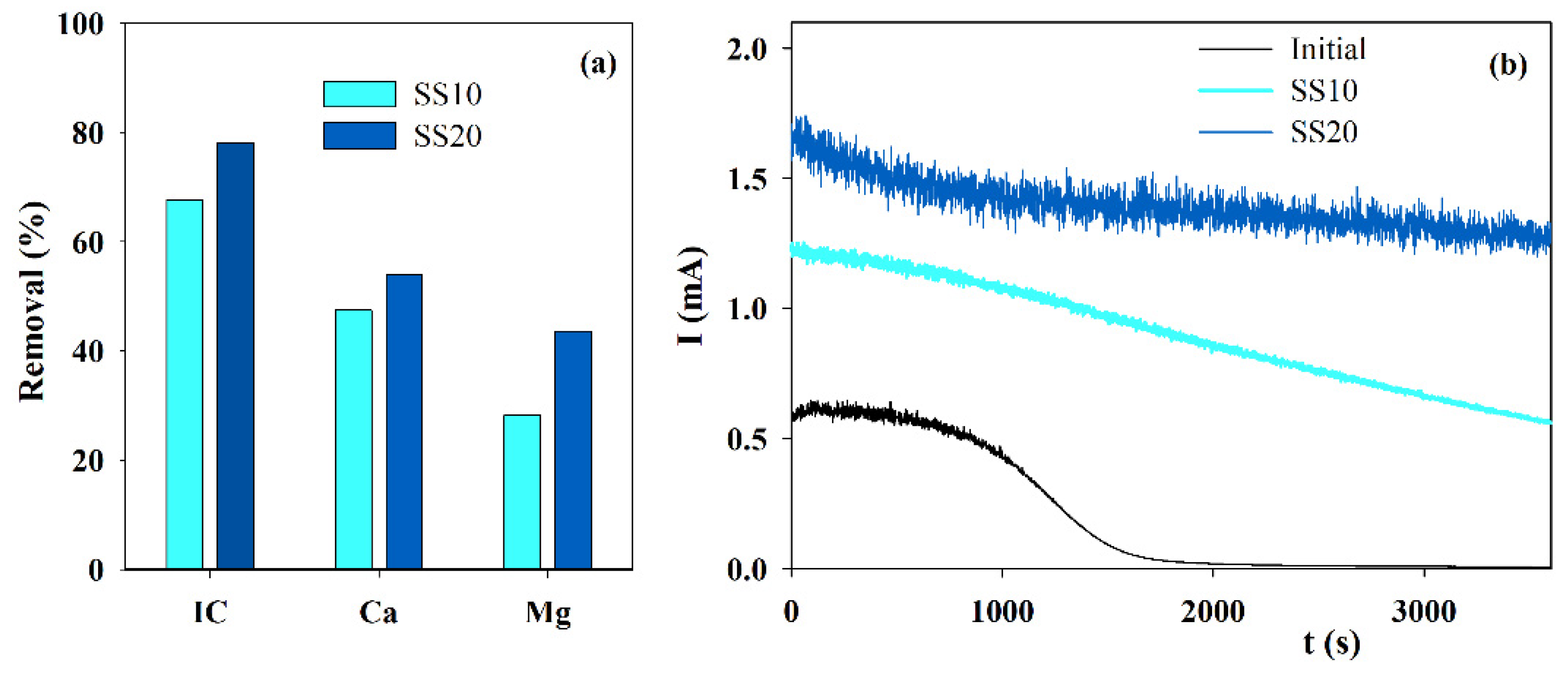
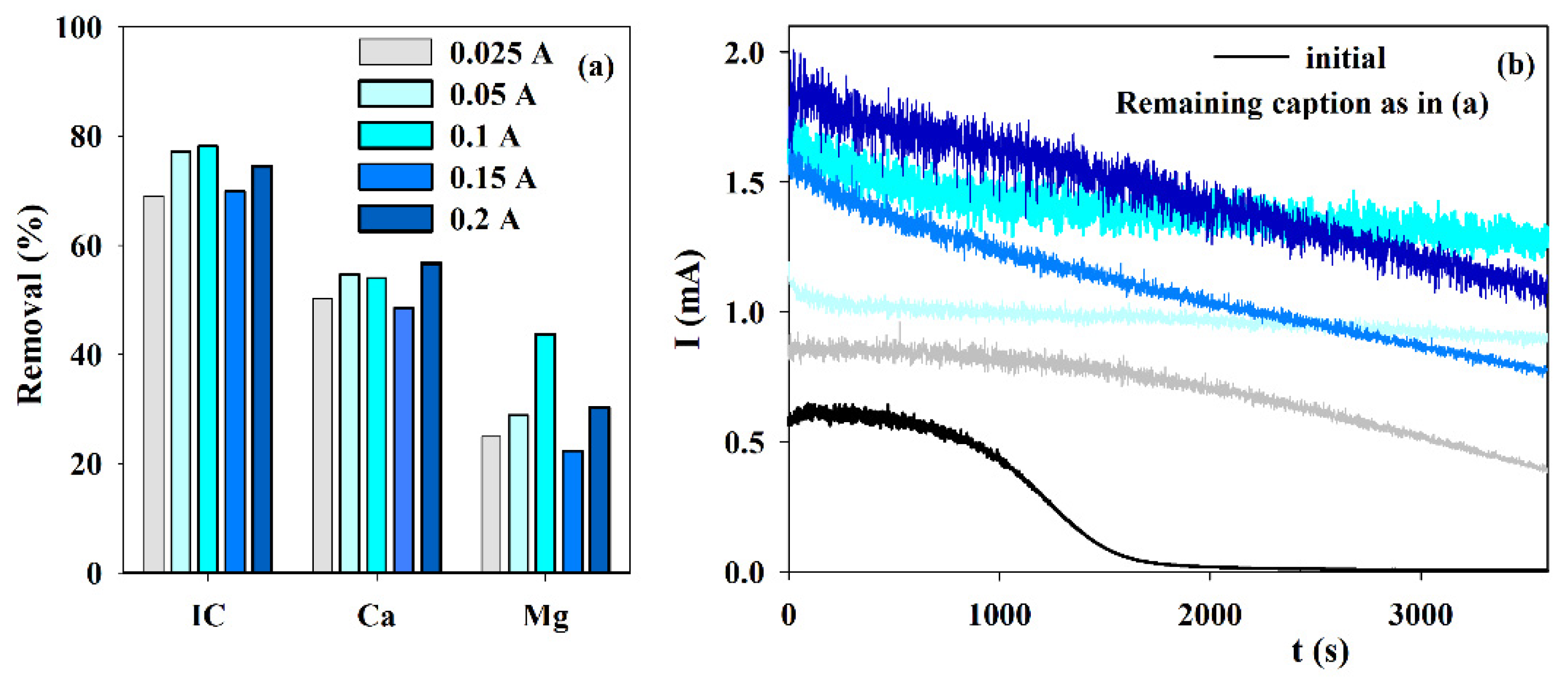
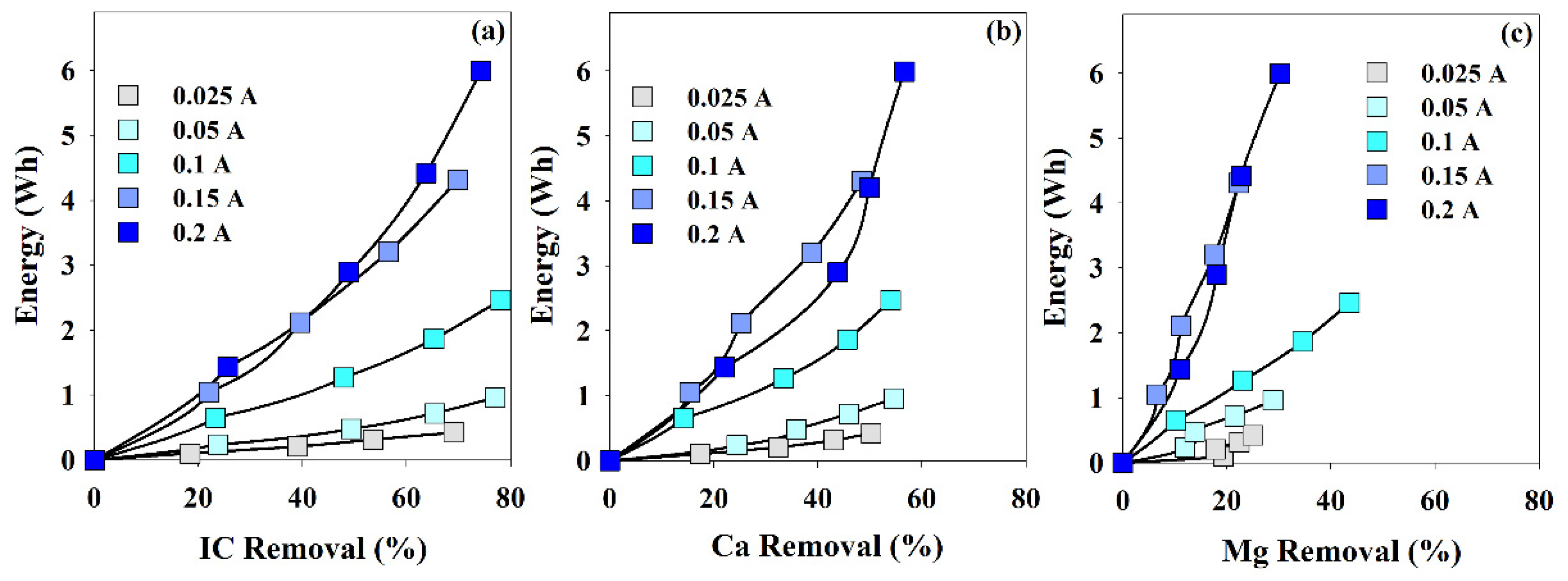
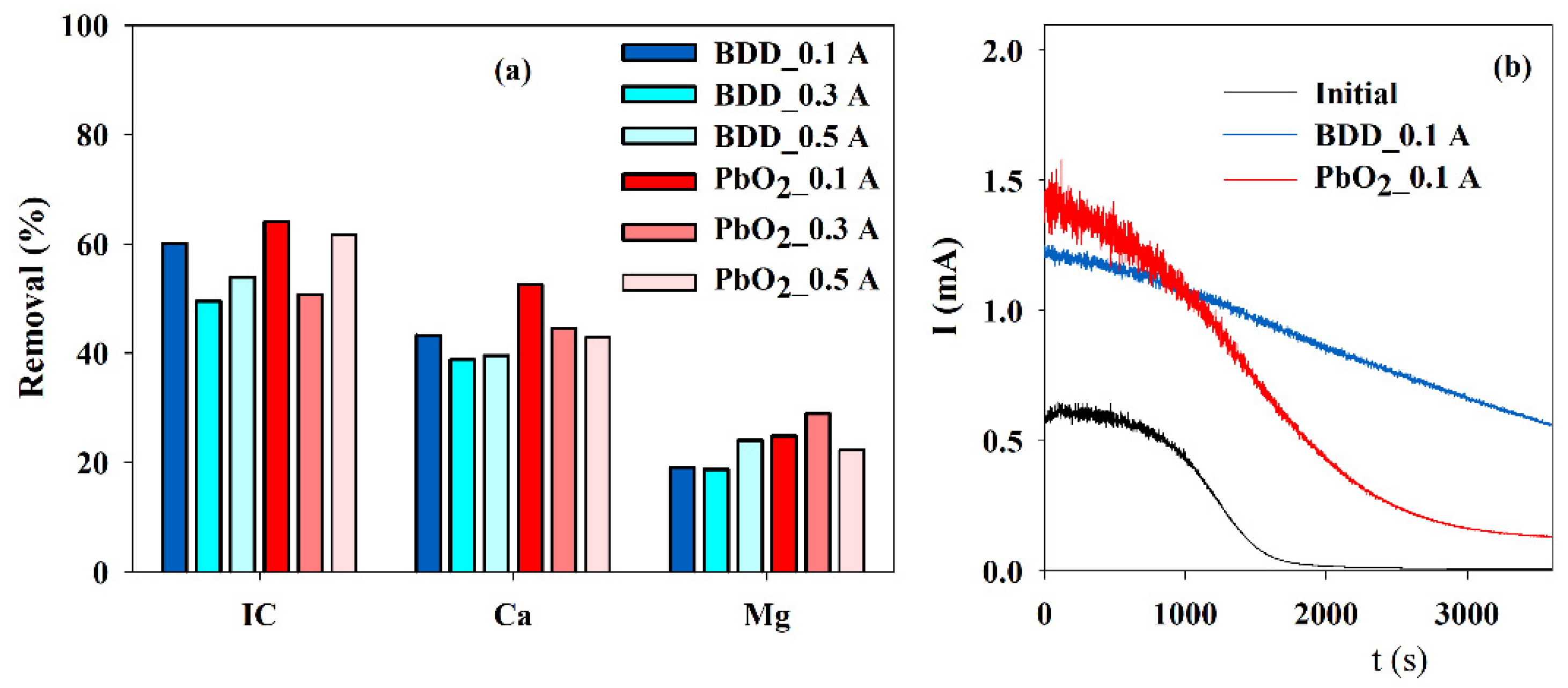
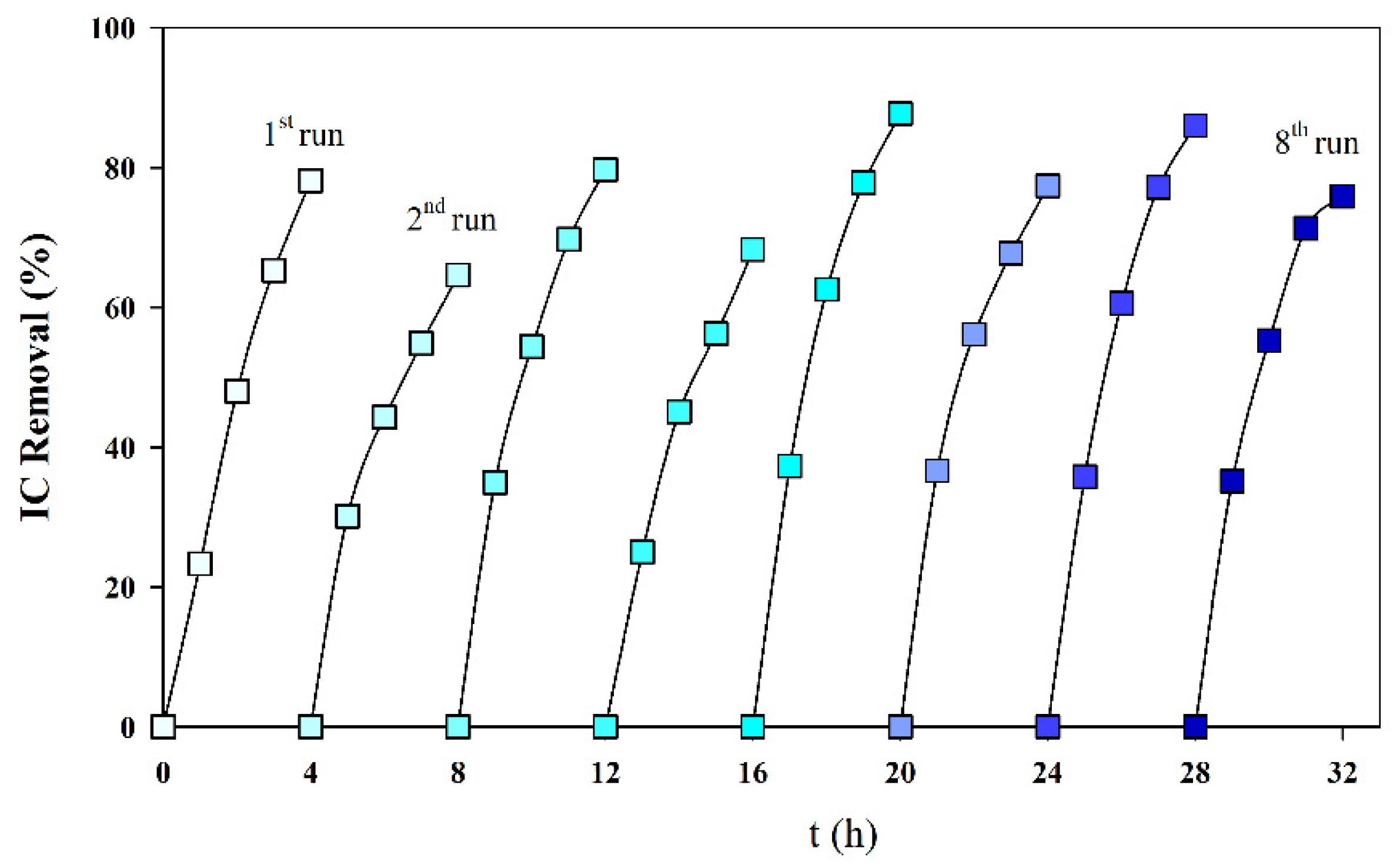

| Parameter | Solution | ||||||
|---|---|---|---|---|---|---|---|
| S | A | B | C | D | E | ||
| [HCO3−] | /mg L−1 | 350 | 200 | 200 | 200 | 200 | 200 |
| [Mg2+] | 40 | 200 | 150 | 100 | 50 | 0 | |
| [Ca2+] | 170 | 0 | 50 | 100 | 150 | 200 | |
| HCO3− | molar fraction | 0.49 | 0.28 | 0.30 | 0.33 | 0.36 | 0.40 |
| Mg2+ | 0.14 | 0.72 | 0.58 | 0.42 | 0.23 | 0 | |
| Ca2+ | 0.37 | 0 | 0.12 | 0.25 | 0.41 | 0.60 | |
| Parameter | I/A | |||||
|---|---|---|---|---|---|---|
| 0.025 | 0.05 | 0.10 | 0.15 | 0.20 | ||
| Final pH | 6.9 | 6.6 | 6.8 | 7.1 | 7.1 | |
| Conductivity reduction/µS cm−1 | 365 | 440 | 563 | 507 | 584 | |
| SEC/kWh kg−1 | IC | 16.6 | 32.5 | 85.0 | 192.8 | 217.6 |
| Ca2+ | 9.0 | 20.2 | 47.05 | 98.2 | 104.0 | |
| Mg2+ | 71.2 | 176.6 | 265.2 | 978.6 | 929.0 | |
| Parameter | BDD | Ti/Pt/PbO2 | |||||
|---|---|---|---|---|---|---|---|
| 0.1 A | 0.3 A | 0.5 A | 0.1 A | 0.3 A | 0.5 A | ||
| Final pH | 8.0 | 7.3 | 7.4 | 7.3 | 7.6 | 7.6 | |
| Conductivity reduction/µS cm−1 | 405 | 399 | 398 | 381 | 449 | 509 | |
| SEC/kWh kg−1 | IC | 114 | 810 | 1709 | 124 | 972 | 2028 |
| Ca2+ | 47 | 381 | 895 | 60 | 447 | 1232 | |
| Mg2+ | 265 | 3578 | 6653 | 559 | 3038 | 9810 | |
| Element | Molar % | |
|---|---|---|
| Front Side | Back Side | |
| C | 10.7 | 7.3 |
| Ca | 11.6 | 9.0 |
| Mg | 10.0 | 13.2 |
| Na | 0.2 | 0.3 |
| Cl | 0.1 | 0.1 |
| O | 67.4 | 70.1 |
Publisher’s Note: MDPI stays neutral with regard to jurisdictional claims in published maps and institutional affiliations. |
© 2021 by the authors. Licensee MDPI, Basel, Switzerland. This article is an open access article distributed under the terms and conditions of the Creative Commons Attribution (CC BY) license (https://creativecommons.org/licenses/by/4.0/).
Share and Cite
Souiad, F.; Bendaoud-Boulahlib, Y.; Rodrigues, A.S.; Fernandes, A.; Ciríaco, L.; Pacheco, M.J.; Lopes, A. Electrodeposition of Calcium Carbonate and Magnesium Carbonate from Hard Water on Stainless-Steel Electrode to Prevent Natural Scaling Phenomenon. Water 2021, 13, 2752. https://doi.org/10.3390/w13192752
Souiad F, Bendaoud-Boulahlib Y, Rodrigues AS, Fernandes A, Ciríaco L, Pacheco MJ, Lopes A. Electrodeposition of Calcium Carbonate and Magnesium Carbonate from Hard Water on Stainless-Steel Electrode to Prevent Natural Scaling Phenomenon. Water. 2021; 13(19):2752. https://doi.org/10.3390/w13192752
Chicago/Turabian StyleSouiad, Faléstine, Yasmina Bendaoud-Boulahlib, Ana Sofia Rodrigues, Annabel Fernandes, Lurdes Ciríaco, Maria José Pacheco, and Ana Lopes. 2021. "Electrodeposition of Calcium Carbonate and Magnesium Carbonate from Hard Water on Stainless-Steel Electrode to Prevent Natural Scaling Phenomenon" Water 13, no. 19: 2752. https://doi.org/10.3390/w13192752
APA StyleSouiad, F., Bendaoud-Boulahlib, Y., Rodrigues, A. S., Fernandes, A., Ciríaco, L., Pacheco, M. J., & Lopes, A. (2021). Electrodeposition of Calcium Carbonate and Magnesium Carbonate from Hard Water on Stainless-Steel Electrode to Prevent Natural Scaling Phenomenon. Water, 13(19), 2752. https://doi.org/10.3390/w13192752







